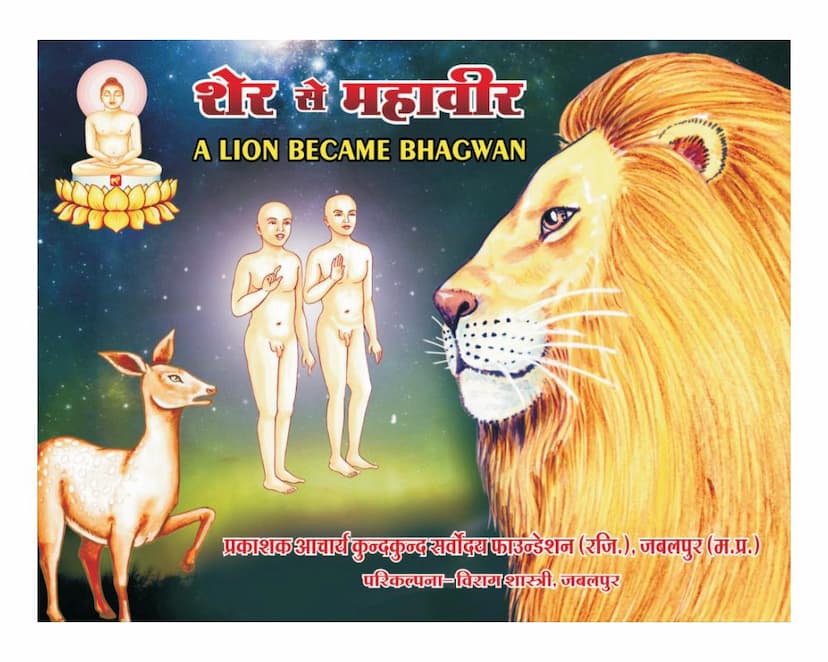Sher Bana Mahaveer
Added to library: September 2, 2025

Summary
Here's a comprehensive summary of the Jain text "Sher bana Mahaveer" (A Lion Became Bhagwan) by Virag Shastri, published by Acharya Kundkund Sarvodaya Foundation:
Core Narrative:
The book tells the story of a lion that undergoes a profound transformation after encountering two Jain monks. The narrative is presented as a moral tale to illustrate the Jain principle of spiritual evolution and the potential for even the lowest beings to achieve liberation through right understanding and conduct.
The Story Unfolds:
- The Lion's Predatory Act: The story begins with a hungry lion in the jungle, which spots and hunts a deer. The lion brutally kills the deer, tearing its stomach open with its sharp claws.
- The Monks' Intervention: At this crucial moment, two Jain monks, Amitkirti and Amitprabh, are spiritually traveling (viharing) through the sky. They witness the lion's violent act.
- The Lion's Astonishment and Transformation: The monks descend and approach the lion. Their extreme peacefulness and serene demeanor captivate the lion, causing it to stop eating and look at them with surprise. The text suggests the lion could understand the essence of their teachings, leading to a cessation of its violent behavior.
- The Prophecy and Repentance: The monks, recognizing the lion's potential for future spiritual growth, reveal that he is a "near Bhavya jiva" (a soul destined for liberation) and will, in ten more lifetimes, become the Tirthankar Mahaveer in Bharat Kshetra. This revelation moves the lion deeply, and tears of repentance flow from its eyes. It reflects on its actions and achieves Samyak Darshan (right faith/perception).
- The Lion's Subsequent Life and Death: Following this realization, the lion stops eating meat. As a consequence of not eating, its body weakens, and it becomes unable to move. Birds then begin to consume its flesh, believing it to be dead. The lion, in this weakened state, dies peacefully, having achieved Samyak Darshan.
- Rebirth and Ultimate Destiny: The narrative then shifts to the lion's next life. It is reborn as Sinhketu Dev in Saudharma Swarg (a celestial realm). After completing nine more such lives (births and deaths), the same soul eventually incarnates as the twenty-fourth Tirthankar, Bhagwan Mahaveer.
Key Themes and Messages:
- Spiritual Potential: The central message is that any being, even an animal engaged in violence, has the potential for spiritual advancement and liberation. The path to this lies in understanding the self and adopting right conduct.
- The Power of Spiritual Guidance: The encounter with the monks highlights the transformative power of spiritual guidance and virtuous presence. Their peaceful demeanor and prophetic words trigger a profound change in the lion.
- Repentance and Purity: The lion's tears symbolize sincere repentance for its past deeds. This act of renunciation and remorse is crucial for spiritual progress.
- The Cycle of Rebirth and Karma: The story illustrates the Jain concept of karma and rebirth, showing how present actions and spiritual understanding influence future lives, ultimately leading to the highest spiritual attainment.
- The Importance of Samyak Darshan: The lion's achievement of Samyak Darshan marks a turning point, signifying the initial step towards liberation by recognizing the true nature of reality.
- Moral Lesson for Children: The book is clearly aimed at educating children about Jain principles. It emphasizes that even an animal can become a divine being through self-realization, encouraging children to also focus on their spiritual well-being for eternal happiness.
Publisher's Note (Page 13):
The publisher, Acharya Kundkund Sarvodaya Foundation, highlights the increasing need for imparting Jain values in today's materialistic world. They emphasize that Jainism brings peace and that preserving this heritage is a moral duty. The foundation has been actively promoting spiritual education for children and adolescents through various means, including videos and publications, with the aim of inspiring them with the stories of their great lineage.
Available Resources (Page 14):
The foundation also lists other resources they offer, including:
- Children's religious videos (animated and otherwise) on various Jain themes and stories.
- Religious games for children.
- Books of Jain stories and poems.
- A Jain children's magazine called "Chahakti Chetna."
In essence, "Sher bana Mahaveer" is a beautifully illustrated Jain story that uses the dramatic transformation of a lion to convey the profound spiritual journey leading to ultimate liberation, as exemplified by Bhagwan Mahaveer.